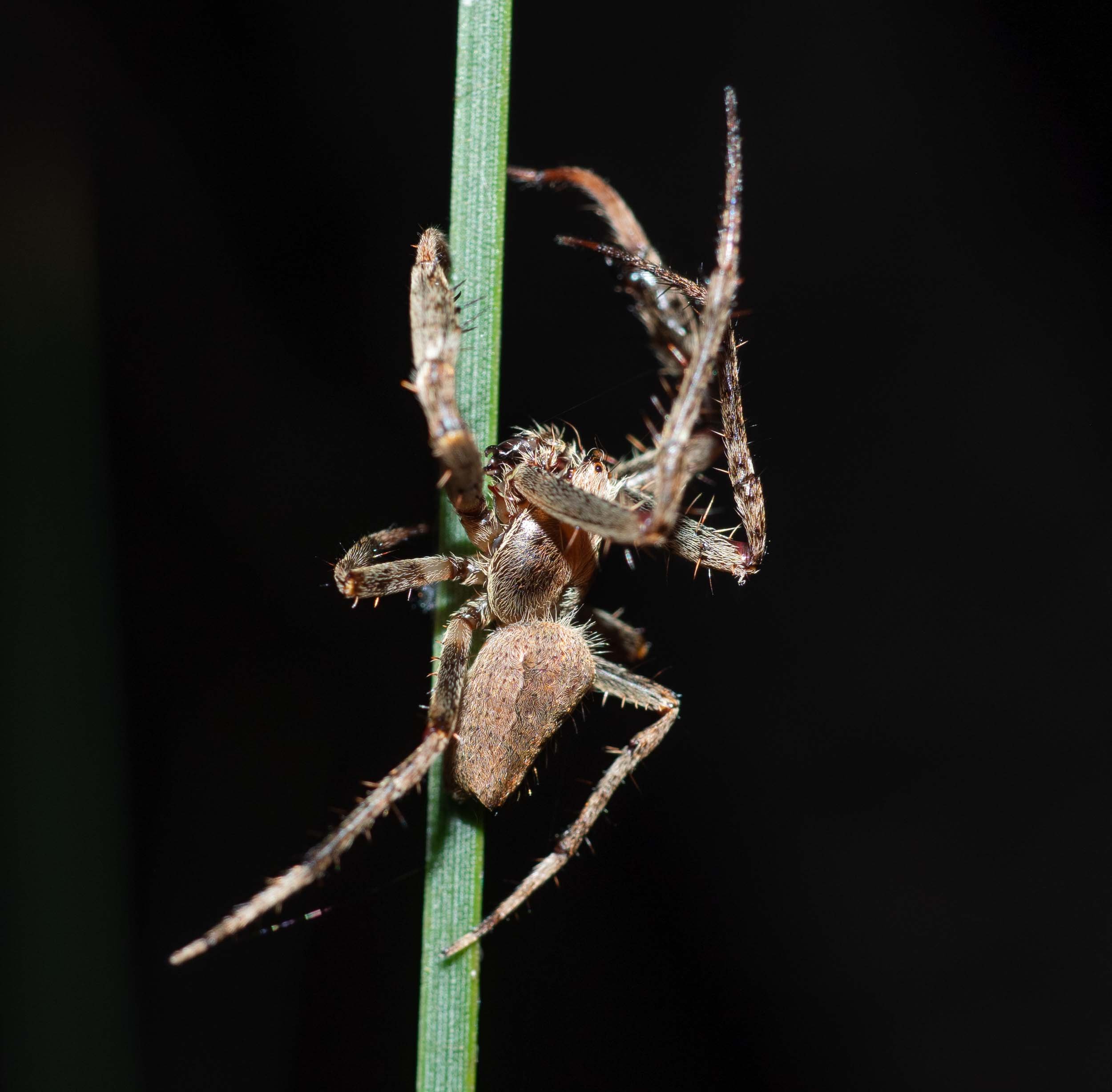Hortophora tatianeae

Workbook
A recent revision of Australian orb-weaver spiders (family Araneidae) (Framenau et al 2021) has established a new genus Hortophora to accomodate spiders previously placed in Araneus and Eriophora. We have previously identified various orb-weavers in our forest as Eriophora sp (iNaturalist ID nos. 67833280, 105644108, 107019636, 107019637) or Eriophora transmarina (57994712, 60296999, 147667611, 147932177).
Following Susie and Jim’s correction of my ID of the last of these spiders (147932177), I downloaded the Framenau et al paper and used it to try to identify this spider (a male) to species level.
Gallery #1 shows photos taken on the night we found the spider (2/2/23, at 21:42) on Wombat track, close to the junction of Xantho loop and Lot 6 track.
Gallery #1
We decided to collect this individual for closer examination.
We found him in the same position 3 days later.
I accidentally broke his web which ran across the track and then photographed him on a Acacia mearnsii twig on the side of the track.
We collected him in a plastic jar.
I transferred him to a petri dish and photographed him with my 60mm macro lens.
Gallery #2
I then imaged the living spider under the Tessovar as he clung immobile to the underside of the lid to obtain higher magnification images, particularly of the pedipalps.
Gallery #3
To obtain more detailed views of the pedipalps, I decided I needed to sacrifice the spider. I placed him in the freezer overnight to kill him, then placed him in 100% ethanol and re-photographed various body parts.
Images of the ethanol-treated spider are shown in galleries 4-5.
Gallery #4
I removed the left pedipalp and photographed it from various orientations. I also photographed other body parts, including chelicerae, the sternum and the tibia of leg II.
Gallery #5
Application of the key in Framenau et al 2021 leads to a species ID of Hortophora tatianeae.
Abdomen not drawn out dorsally and without lateral humps (vs. drawn out dorsally and arching posteriorly beyond spinnerets, excludes H. cucullus) - see Gallery #3, image 5. and Gallery #4, image 1
Coxa II without apico-ventral hook (vs. with apico-ventral hook, excludes H. biapicata) - see Gallery #5, image 8
Median apophysis of male pedipalp elongate transverse and ending in two (rarely one or three) apical, ventrally vent small hooks (vs. ending in one or two broad apical lobes, excludes H. yesabah, H. walesiana, H. lodicula) - see Gallery #5, image 2
Median apophysis with distinct central protrusion (vs. without central protrusion, excludes H. megacantha and H. porongurup) - see Gallery #4, protrusion arrowed in image 4
Total length < 12mm; tibia of leg II with less than 15 strong prolateral and ventral spines and apico-ventral spur distinct; abdomen venter with two narrow lateral light lines and pairs of light spots in between (vs. total length > 12mm; tibial of leg II with more than 20 strong prolateral and ventral spines and apico-ventral spur indistinct; abdomen ventral with broad, transverse light bands, excludes H. transmarina) - see Gallery #3, image 5; Gallery #5, image 5,6; Gallery #3, image 6, Gallery #4, image 3 (Note that the “narrow lateral light lines on the venter” are not obvious in this spider, but Framenau et al state in their diagnosis of the Hortophora genus these lines are “indistinct”).
Other features evident in this male spider are also in accord with the description of the holotype of Hortophora tatianeae in Framenau et al 2012, as noted below.
Note that comparisons of colour and pattern are best made with my specimens in alcohol, as this is how the holotype was preserved:
Total length of holotype 7.8mm, range 6.3-11.3. Our spider is 7.7mm long (Gallery #3, image 5).
Carapace - centrally beige, with dark brown lateral flanks (Gallery #4, image 1), white setae particularly centrally (Gallery #3, image 5)
Chelicerae dark brown, three promarginal teeth widely separated on sclerotised irregular ridge, three retromarginal teeth of same size (Gallery #5, image 4). Note that my spider shows four rather than three retromarginal teeth. However, we have noted variation in numbers of cheliceral teeth in our description of the funnel-web spider Hadronyche nadgee. So this difference is perhaps not surprising.
Legs dark brown with light discolourations, particularly basally on all femora and hooks on coxae I (Gallery #4, images 1,2)
Tibiae of leg II enlarged with apico-ventral megaspur that carries a strong spine, additional strong spines ventrally and prolaterally (Gallery #5, images 5,6)
Metatarsus of leg II heavily bent (Gallery #5, image 5, Gallery #3, image 6)
Sternum 1.8mm long, 1.3mm wide, brown, with darker discolorations (Gallery #5, image 7)
Abdomen 4.0mm long, 2.8mm wide, dorsum with humeral humps, dark brown folium pattern and central white guanine patches (Gallery #4, image 1)
Venter olive-brown with two white lateral lines and ca. four pairs of white spots centrally (Gallery #3, image 6 in spider before immersion in alcohol, Gallery #4, image 3 of spider after immersion in alcohol)
Details of pedipalp morphology: paracymbium elongated with terminal hook; median apophysis transverse elongate with central pointy protrusion and terminating in two sclerotized apical tips; conductor lobe of standard size; terminal apophysis bubble-shaped tapering into a short sclerotised tip; conductor apically and basally sclerotised and with a lamellar, excavated central portion; embolus sinuous with acute tip (Gallery #4, images 4-6; Gallery #5, images 1-3).
The similarity between the Framenau et al Figs. 21C, 21D and my Gallery #5 images 2, 1 respectively is striking.
This species is widely distributed along the east coast, from Cairns to western Victoria.
This is a workbook page … a part of our website where we record the observations and references used in making species identifications. The notes will not necessarily be complete. They are a record for our own use, but we are happy to share this information with others.











































